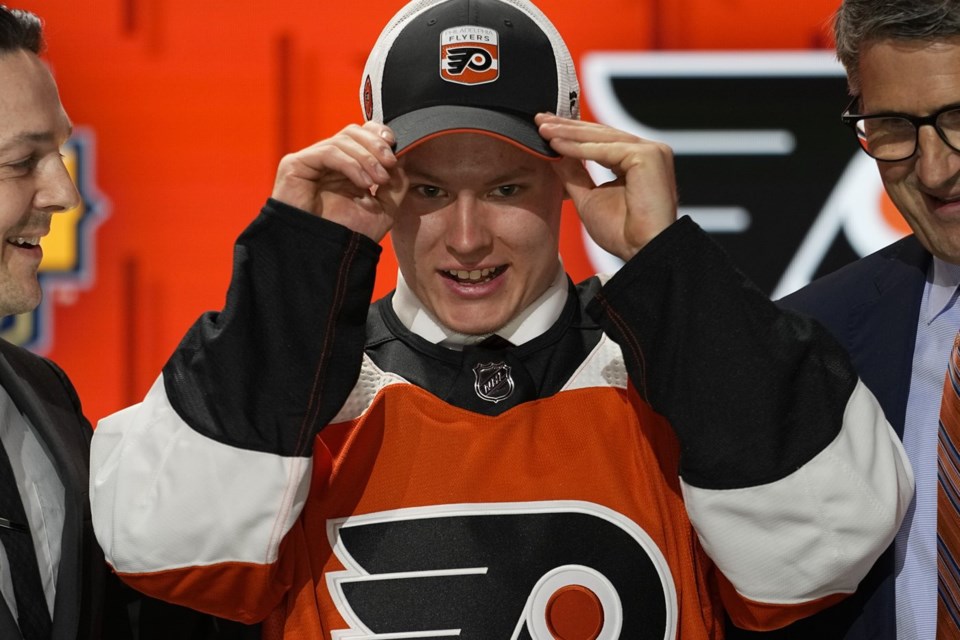If NHL general managers and most scouts are unable to enter Russia to rate the talent in person, player agent Daniel Milstein figured, why not bring his draft-eligible prospects to North America?
That was the case earlier in June, when Milstein and several agents with Russian clients held their own combine in Florida, which he said attracted representatives from all but one of the league’s 32 teams. He has previously held pre-draft camps, but this was the first open to all NHL teams.
“I had a full house,” Milstein told The Associated Press, declining to say which team did not attend. “Talent-wise, and you can quote me on this: I’m not sure that we had any less talent than the actual NHL combine.”
That might be a stretch, given the annual NHL combine held in Buffalo, New York, two weeks earlier featured nearly 100 prospects, , who is projected to be selected first by San Jose when the draft opens in Las Vegas on Friday.
Up close and personal
What can’t be understated is the importance for NHL talent evaluators to see and meet with Russian prospects many otherwise have no access to because of travel restrictions, and since its invasion of Ukraine.
Among the highly touted prospects in attendance were Russian junior forward Ivan Demidov, who is ranked second among NHL Central Scouting international players, and projected to be a top-five pick.
Milstein’s Gold Star camp, named after his agency, included on-ice practices and scrimmages, something the NHL combine doesn’t feature. Just as important, Milstein had his clients spend the past year learning English to better prepare for the jump to North America.
Without going into detail, Milstein said his agency has also found a way to fast-track Russian players getting visas to play in North America.
“The kids come in, interview extremely well. They’re fit. They do well in the testing,” Milstein said. “And because the camps are here in North America, they’ve showing the entire world that, look, we’re open for business. We’re here because we want to play.”
Russian reservations
. They range from having no control over their prospect’s development and ice time in Russia, to concerns over if or when those players choose to come to North America.
“It’s definitely more of a gamble at this time,” an NHL executive told The AP, speaking on the condition of anonymity because of the delicate climate involving getting players to leave Russia. “You are at the mercy of their team over there.”
NHL Central Scouting director Dan Marr noted some players who leave Russia are fearful of returning.
“It’s a very tough situation,” Marr said. “And remember, we’re still taking teenagers here. This is life’s adversity very front and center.”
Milstein acknowledged a higher degree of risk involved in drafting Russian players, which is what prompted him to help break the barriers by hosting a camp, and allowing NHL executives to learn of a player’s future plans firsthand.
Past issues
The Philadelphia Flyers had to wait nine years for , following a complicated and secretive journey, and only after CSKA Moscow terminated his contract in Russia’s KHL. After signing with the Flyers in May 2022, the 2015 draft pick was taken by authorities to a remote military base in the Arctic Circle for a year of service.
The Flyers did receive encouraging news on Sunday of their top prospect, С����Ƶ released from his KHL contract in what is regarded as the first step toward joining them this season.
The NHL’s issues over drafting Russian players date to the late 1980s, when the Buffalo Sabres smuggled Alexander Mogilny out of Sweden after he represented Russia at the world junior championship tournament. In the late 2000s, more Russian players stayed home following the launch of the KHL, with its ability to offer competitive contracts.
Then came the pandemic in 2020, which restricted international travel and canceled play, followed by the NHL ceasing business relations with Russia following the start of the war in 2022.
The restrictions, however, have had little impact on the number of Russian players С����Ƶ drafted — though the numbers also reflect Russian players choosing to play in U.S. colleges or the USHL.
At least 19 Russian players were selected in each of the seven-round drafts dating to 2017. That includes 29 taken in ’21 — the most since that many were selected in 2003 when the draft was nine rounds.
Sabres assistant general manager Jerry Forton rates the value of selecting Russian players on a case-by-case basis. Of the five Russians the Sabres have drafted since 2021, three are currently in their system while two have yet to sign, including Prokhor Poltapov, a ’21 second-round selection who is under contract with his KHL team through 2025.
The Sabres are hoping Poltapov will be able to join them after his contract expires, though they’re aware of him С����Ƶ offered a five-year extension, which the player has rejected. Forton was among three Sabres representatives attending Milstein’s camp.
“They prepared them well,” Forton said, referring to organizers. “I don’t think that was always the case in the past. So they might be getting a little more sophisticated on their end in terms of prepping and exposing them for the draft.”
___
AP NHL: https://apnews.com/hub/nhl
John Wawrow, The Associated Press




